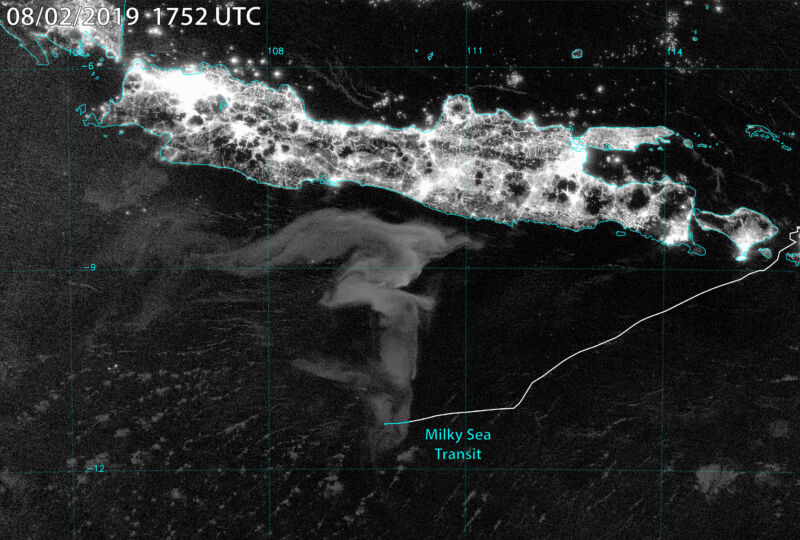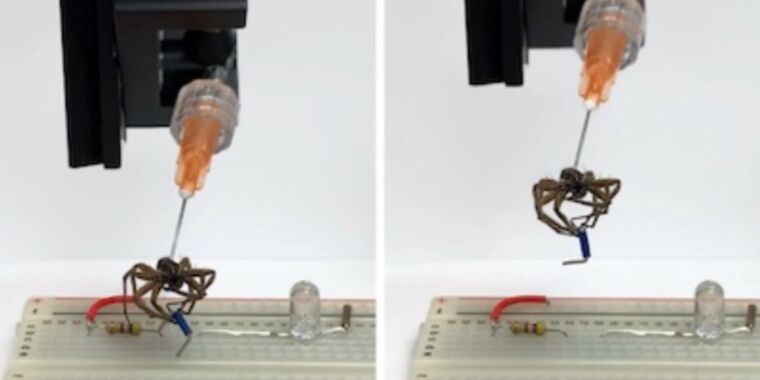
On some moonless nights, enormous patches of the Northwest Indian Ocean and seas around Indonesia begin to glow. This event has been witnessed by hundreds of sailors, but only one research vessel has ever, by pure chance, come across this bioluminescent phenomenon, known as milky seas. Thanks to that vessel, samples showed that the source of the light was a bacteria called V. harveyi, which had colonized a microalgae called Phaocystis. But that was back in 1988, and researchers have yet to be in the right place and the right time to catch one of these events again.
Both the bacteria and algae are common to those waters, so it’s not clear what triggers these rare events. To help understand why milky seas form, researchers have gotten much better at spotting these swaths of bioluminescence from the skies. With the help of satellites, Stephen Miller, a professor of atmospheric science, has been collecting both images and eyewitness accounts of milky seas for nearly 20 years. Thanks to improvements in the imaging capabilities over the past decades, Miller published a compilation last year of probable milky seas in the time frame of 2012 to 2021, including one occurrence south of Java, Indonesia, in summer 2019.
But these satellite observations lacked surface confirmation—that is, until the crew of the yacht Ganesha reached out to Miller with their first-hand account of what they had experienced during their trip through the seas around Java that August, which was recently published in PNAS. Their eyewitness corroboration—along with the first photographs of a milky sea—show that these satellites are indeed a powerful tool for spotting these events.
Skies’ eyes
Although milky seas can be massive—greater than 100,000 square kilometers in the case of the 2019 sighting—the intensity of this bioluminescence is still relatively faint. By comparison, the better-known sea sparkle from marine plankton (dinoflagellates) is 10 times stronger—and even that can be hard to spot.
To catch milky seas by satellite, researchers like Miller and his collaborators had to wait for the installation of the Day/Light Band on the latest generation of National Oceanic and Atmospheric Administration (NOAA) environmental satellites. This low-light imager is sensitive enough to capture light 10,000 times weaker than reflected moonlight and about 1 billion times weaker than reflected sunlight. Day/Light Bands have been installed on two satellites: the Suomi National Polar-orbiting Partnership (launched in 2011) and the Joint Polar Satellite System series (launched in 2017).
Thanks to these satellites, Miller could search through 10 years of satellite data, in which he found 12 suspected milky seas between 2012 and 2021. This data showed that the events could last as long as weeks and that they often coincided with regional monsoons and algal blooms resulting from the upwelling of nutrient-rich waters.
“While milky seas are spectacular visual phenomenon with an interesting historical backstory tied to the maritime folklore, I think in modern times we are also very interested in understanding how and why this massive expression of our biosphere, associated with primary production (the very base of the marine food chain), occurs,” writes Miller in an email to Ars Technica. “I would like to translate this to a better awareness of atmosphere/ocean/biosphere coupling in Earth’s climate system, such that we can begin to understand how fundamental components of our planet’s ecosystem may respond in a changing climate.”
But all of Miller’s observations were coming from an altitude of over 800 km in the sky—until he heard from the Ganesha crew.








